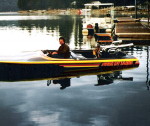SO, it looks like from my limited knowledge and understanding of the TFF / BFF boats of old, that the speeds of the TAF are well beyond any of the fuel records...
Can someone give me a sanity check on this???
Panic Mouse was in the neighborhood of 155MPH and I see that the new 2013 TAF record speed is north of 160???
Was there an era of FUEL flats that were up north of 155MPH???
I have my Don Edwards DRAG BOAT book but Im too lazy to go and look up the numbers... BESIDES, it will be a fun and spirited discussion with different views/perspectives I'm sure...
Results 1 to 10 of 45
Thread: Flattie DRAG BOAT Top Speeds...
-
01-15-2014, 09:47 AM #1
Flattie DRAG BOAT Top Speeds...
-In a Republic, the sovereignty resides with the people themselves. In a Republic, the government is a servant of the people, and obliged to its owner, We the People..
"Remember, democracy never lasts long. It soon wastes, exhausts, and murders itself. There never was a democracy yet that did not commit suicide." John Adams
-
01-15-2014, 10:01 AM #2WESTERNAEROGuest
Are you seriously trying to compare a fuel engine from 40 years ago to an alky engine built today?

-
01-15-2014, 10:32 AM #3
-
01-15-2014, 10:44 AM #4
Nope, not the engines but rather the hulls... and the limits of the hulls...
SO Rick Williams talked about 173+ MPH with the Trojan Ghost and I see 176 MPH... (TY for the video Jerry, I forgot about that clip with Mr Williams)...
What are the limits, where is the ragged edge/top speed of a flattie with regard to TOP speed and bringing it back down safely???
SO the current fastest FLAT class (TAF) are getting very close to the highest speeds ever clocked in a flat bottom hull...
Last edited by 2manymustangs; 01-15-2014 at 10:52 AM.
-In a Republic, the sovereignty resides with the people themselves. In a Republic, the government is a servant of the people, and obliged to its owner, We the People..
"Remember, democracy never lasts long. It soon wastes, exhausts, and murders itself. There never was a democracy yet that did not commit suicide." John Adams
-
01-15-2014, 11:12 AM #5
-
01-15-2014, 11:29 AM #6WESTERNAEROGuest
You need to explain this Bob. The hemis from long ago don't even compare to the hemis today. Technology in manufacturing has changed this tremendously. I don't know what kind of power the old fuel motors were making but it can't be close to what the alky motors are making these days. I'm not talking about fuel vs alcohol in the same motor today. I'm talking about new alky motor vs old fuel motor.
Am I way off here? Please explain.
-
01-15-2014, 11:45 AM #7
Again, im asking more about the limits of the flattie hull versus the engine... There must be some limit to the flattie hull NOT having the training wheels of a hydro...
As for the fuel engines versus alcohol, this may help in terms of where Bob is coming from, fuel is a total game changer in terms of power. New or old, it's still just an air pump no matter if the new engines are more precise/tighter tolerances/strength:
Nitromethane
This slightly viscous liquid was originally created as a solvent for use in the dry cleaning industry. Its first use in competition is shrouded with various first-use claims, but among the accomplishments of record is nitro's first successful use in a circle track Midget driven at the famous Gilmore Stadium in 1950 by future Indy 500 winner Roger Ward and tuned by Vic Edelbrock Sr. The drag racers who experimented with the fuel in the early '50s, included Joaquin Arnett of Bean Bandits fame. The secret to power is hidden in nitromethane's chemical formula of CH3NO2. That O2 at the end is oxygen, which separates its chemical bonds to nitrogen during combustion and allows the oxygen to contribute to the combustion process. With gasoline, the air/fuel ratio for best power is 12.5 parts air to one part fuel (12.5:1). But because nitromethane contains its own oxygen, fuel racers long ago discovered that the more fuel you could feed the engine, the more power it made, bringing the air/fuel ratio closer to a 1:1 ratio.
Miller says if you compute the actual mechanical ratio of air and fuel with today's fuel engines, "the numbers get closer to 3 pounds of nitro for every 1 pound of air. But a lot of this fuel is used to cool the burn. People don't know this, but nitro, alcohol, and gasoline all have very similar burn rates," Miller says. "In fact, nitro is in between gasoline and methanol. All that lead [ignition timing] is due to the liquid fuel." In other words, the additional timing is necessary because, Miller says "only 10 percent of what's in the chamber is vapor; the rest is liquid." The vapor burns first, creating enough heat to begin to vaporize the rest of the liquid fuel. But this takes time, which means earlier ignition timing.
Read more: http://www.carcraft.com/techarticles...#ixzz2qUhC8teCLast edited by 2manymustangs; 01-15-2014 at 11:48 AM.
-In a Republic, the sovereignty resides with the people themselves. In a Republic, the government is a servant of the people, and obliged to its owner, We the People..
"Remember, democracy never lasts long. It soon wastes, exhausts, and murders itself. There never was a democracy yet that did not commit suicide." John Adams
-
01-15-2014, 11:48 AM #8WESTERNAEROGuest
Yeah I know what your asking and I'm not trying to change the subject sorry. Maybe Bob can get an engine section going here and he can explain.
-
01-15-2014, 11:50 AM #9
Point being, THEN, they loaded liquid dynamite into the cylinders. Today they don't. That's why the flats then were faster and QUICKER than the flats today. 2MM was only asking about the speeds then compared to today. Engine technology is allowing them to catch up. But its hard to compete against nitrogenated fuel with booze
You no longer can really compare the 2. The TAF are running 320 feet less and its makes hitting 175 plus a little more difficult. But then, they didn't charge the tree back then like they do now. But they still have less room to get to speed.
But a Donovan on crack compared to a Brad 6 on booze. I'll take the Donovan everytime.Last edited by gn7; 01-15-2014 at 11:54 AM.
-
01-15-2014, 11:57 AM #10
Let me ask THIS quesiton...
How many guys (or gals) besides our friend Tony have gone over 160mph in a flattie??? Could we count them on one hand or two hands???-In a Republic, the sovereignty resides with the people themselves. In a Republic, the government is a servant of the people, and obliged to its owner, We the People..
"Remember, democracy never lasts long. It soon wastes, exhausts, and murders itself. There never was a democracy yet that did not commit suicide." John Adams




 Reply With Quote
Reply With Quote




Bookmarks